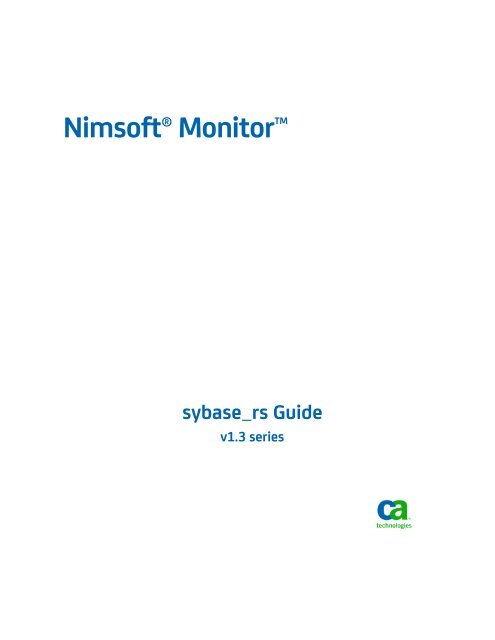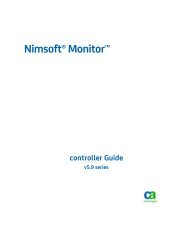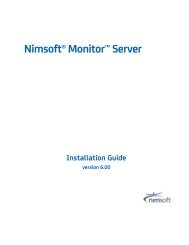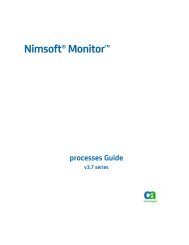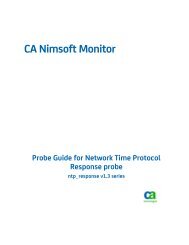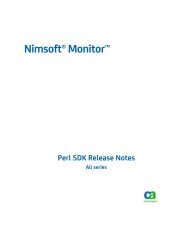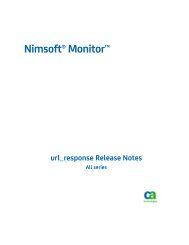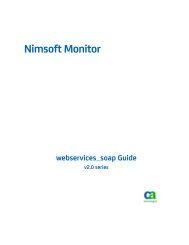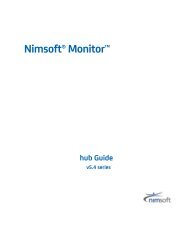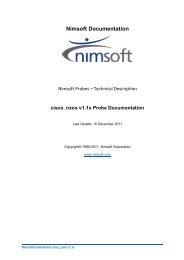Probe Configuration - Nimsoft Library
Probe Configuration - Nimsoft Library
Probe Configuration - Nimsoft Library
Create successful ePaper yourself
Turn your PDF publications into a flip-book with our unique Google optimized e-Paper software.
<strong>Nimsoft</strong>® Monitorsybase_rs Guidev1.3 series
Contact <strong>Nimsoft</strong>For your convenience, CA <strong>Nimsoft</strong> provides a single site where you can accessinformation about CA <strong>Nimsoft</strong> products.At http://support.nimsoft.com/, you can access the following:■■■■■Online and telephone contact information for technical assistance and customerservicesInformation about user communities and forumsProduct and documentation downloadsCA <strong>Nimsoft</strong> Support policies and guidelinesOther helpful resources appropriate for your productProvide FeedbackIf you have comments or questions about CA <strong>Nimsoft</strong> product documentation, you cansend a message to support@nimsoft.com.
ContentsChapter 1: sybase_rs 1.3 7sybase_rs Overview ...................................................................................................................................................... 7Chapter 2: sybase_rs <strong>Probe</strong> Deployment 9Supported Platforms .................................................................................................................................................... 9Hardware Requirements .............................................................................................................................................. 9Software Requirements ............................................................................................................................................... 9Monitoring System Requirements ............................................................................................................................. 10<strong>Probe</strong> Deployment Information ................................................................................................................................. 10Chapter 3: sybase_rs <strong>Configuration</strong> 11<strong>Probe</strong> <strong>Configuration</strong> Interface Installation ................................................................................................................. 11<strong>Probe</strong> Defaults ............................................................................................................................................................ 11<strong>Probe</strong> <strong>Configuration</strong> ................................................................................................................................................... 12The Setup Tab ..................................................................................................................................................... 12The Connections Tab ........................................................................................................................................... 15The Profiles Tab ................................................................................................................................................... 18The Status Tab ..................................................................................................................................................... 27Global alarms ............................................................................................................................................................. 36Chapter 4: QoS Threshold Metrics 37sybase_rs QoS Metrics ............................................................................................................................................... 37sybase_rs Alert Metrics Default Settings ................................................................................................................... 38Contents 5
Chapter 1: sybase_rs 1.3This description applies to sybase_rs version 1.3x.This section contains the following topics:sybase_rs Overview (see page 7)Documentation Changes (see page 8)sybase_rs OverviewThe <strong>Nimsoft</strong> sybase_rs probe enables organizations to centrally monitor all theirreplication servers, thus ensuring that any irregularities in performance and availabilityare detected at the earliest possible stage. The Alarms and Quality of Service data,provided by the sybase_rs probe, makes it possible to detect performance trendsenabling the organization to take precautionary actions before the users notice anydegradations of the service.The probe is typically installed on a central server used for remote monitoring. Onesingle probe may be used to monitor a multiple replication server instances.Chapter 1: sybase_rs 1.3 7
sybase_rs OverviewDocumentation ChangesThis table describes the version history for this document.Version Date What's New?1.3 March 2013 ■ Added support for Sybase Replication Server 15.xon Solaris sparc platform.■Added three new checkpoints;large_transactions, Ping_latency andtransaction_latency1.2 March 2011 Added support for reading alarm tokens fromconfiguration.Related DocumentationDocumentation for other versions of the sybase_rs probe (../../sybase_rs.html)The Release Notes for the sybase_rs probeGetting Started with CA <strong>Nimsoft</strong>® <strong>Probe</strong>sMonitor Metrics Reference Information for CA <strong>Nimsoft</strong> <strong>Probe</strong>s8 sybase_rs Guide
Chapter 2: sybase_rs <strong>Probe</strong> DeploymentThis section contains the system requirements and deployment information for thesybase_rs probe.This section contains the following topics:Supported Platforms (see page 9)Hardware Requirements (see page 9)Software Requirements (see page 9)Monitoring System Requirements (see page 10)<strong>Probe</strong> Deployment Information (see page 10)Supported PlatformsThe sybase_rs probe supports the same set of operating systems and databases assupported by the <strong>Nimsoft</strong> Server solution. Please refer to the <strong>Nimsoft</strong> CompatibilitySupport Matrix for the latest information on supported platforms.Hardware RequirementsThe sybase_rs probe should be installed on systems with the following minimumresources:■■Memory: 2-4GB of RAM. <strong>Probe</strong>'s OOB configuration requires 256MB of RAM'CPU: 3GHz dual-core processor, 32-bit or 64-bitSoftware RequirementsThe sybase_rs probe requires the following software environment:■ <strong>Nimsoft</strong> Monitor Server 5.1.1 or later■ <strong>Nimsoft</strong> Robot 5.23 or later■ Java Virtual Machine 1.6 or later (typically installed with NMS 5.0 and above)Chapter 2: sybase_rs <strong>Probe</strong> Deployment 9
Monitoring System RequirementsMonitoring System RequirementsThe <strong>Nimsoft</strong> sybase_rs probe constantly monitors all replication servers throughout theorganization.The information is presented to the database administrator as alarmsand/or as a report showing areas that need attention.The sybase_rs probe can monitor the below listed platforms:■■■■■Sybase OCS client 12.5.xSybase Replication Server 12.5.xSybase ASE Server 12.5.xSybase Replication Server 15.0.x/Sybase ASE Server 15.x (only on Solaris sparc v964bit)Sybase libraries have to be in system PATH.<strong>Probe</strong> Deployment InformationThere are two ways to distribute archive packages. You can distribute the packagewithin Infrastructure Manager or use the standalone <strong>Nimsoft</strong> Distribution application.See <strong>Probe</strong> Deployment for more information on deploying probes.10 sybase_rs Guide
Chapter 3: sybase_rs <strong>Configuration</strong>This section describes the configuration concepts and procedures for setting up the probe. The sybase_rs probe allows you to monitor replication servers todetect the irregularities in performance and availability in timely manner.This section contains the following topics:<strong>Probe</strong> <strong>Configuration</strong> Interface Installation (see page 11)<strong>Probe</strong> Defaults (see page 11)<strong>Probe</strong> <strong>Configuration</strong> (see page 12)Global alarms (see page 36)<strong>Probe</strong> <strong>Configuration</strong> Interface InstallationThe probe configuration interface is automatically downloaded and installed by the<strong>Nimsoft</strong> Infrastructure Manager when the probe is deployed on a robot.<strong>Probe</strong> DefaultsAt the time of deploying a probe for the first time on robot, some default configurationwill be deployed. For this you have to drag and drop the test template to the profile.These probe defaults could be Alarms, QoS, Profiles, and so on which save time toconfigure the default settings. These probe defaults will be seen on a fresh install, that isno instance of that probe is already available on that robot in activated or deactivatedstate.For the sybase_rs probe, a monitoring profile named Sample Profile is created in whichrsalive, stable_queue_used and thread_status checkpoints are enabled, by default. Youhave to create a connection to Sybase Replication Server and Sybase ASE Server andthen activate the Sample Profile to start monitoring.Chapter 3: sybase_rs <strong>Configuration</strong> 11
<strong>Probe</strong> <strong>Configuration</strong><strong>Probe</strong> <strong>Configuration</strong>The sybase_rs probe configuration interface is used to create connections to SybaseReplication Server, define messages, and create profiles for monitoring the server usingthe checkpoints.There are four main tabs, as listed below:■ Setup (see page 27)■ Connections (see page 15)■ Profiles (see page 18)■ Status (see page 27)The Setup TabThe General TabThe Setup tab is used to define general parameters for the probe. The parameters arecommon for all the profiles. The Setup tab has two sub tabs:■ General (see page 12)■ Message pool (see page 14)The General tab display fields to configure the general run-time parameters regardingthe sybase_rs probe.12 sybase_rs Guide
<strong>Probe</strong> <strong>Configuration</strong>The Message Pool TabThe fields displayed in the above dialog are explained below:Generate status onlyIf selected, the probe generates the status only of the monitoring profile, when athreshold is breached. It does not issues an alarm. You can select the Status tab toview status of different checkpoints.Alarm Severity filterSpecifies a filter on which severity levels are to be considered as alarms.The sybase_rs probe is capable of checking many areas of the Sybase databases.Some events that are generated are vital and have key information related toperformance and availability of the database. As a database administrator, it mightbe required to pass the important event information to the operations centre orhelpdesk to trigger SMS, emails and so on.The Alarm Severity filter will consider the events as alarms, matching the selectedseverity level and higher, and pass them to the <strong>Nimsoft</strong> Alarm Server whenever theGenerate status only option is not selected.For example, if you set this to be major, then only messages with severity levelmajor and upward are considered as alarms.Log-levelSets the level of details written to the log file. Log as little as possible during normaloperation, to minimize disk consumption.The Message pool tab displays a list of all alarm messages available for the probe.Chapter 3: sybase_rs <strong>Configuration</strong> 13
<strong>Probe</strong> <strong>Configuration</strong>You can select messages from this list while editing the properties for a checkpoint.Right-clicking in the list displays the following options:■■■■New: Allows you to add new messages to the message pool.Copy: Allows you to copy existing message details to create new message to thepool.Edit: Allows modifying existing message details.Delete: Removes a message from the pool.Refer the Edit Message (see page 14) section for more details.Edit MessageThe Edit Message dialog appears on selecting Add, Copy or Edit option from theright-click menu of the Message Pool tab.The fields displayed in the above dialog are explained below:CheckpointAllows you to select the checkpoint, for which you are creating the alarm message.VariablesDisplays a list of variables, which can be used in the message text.Message textDefines a message text, which can be combination of static text and variables.14 sybase_rs Guide
<strong>Probe</strong> <strong>Configuration</strong>On selecting the New or Copy option, prior to Edit Message dialog, the New messagedialog also appears.You need to specify name of the message in this dialog.Tip: Use the name of the checkpoint, in message name, for which you are creating thealarm message. It makes easier to find the alarm message when selecting an alarmmessage in the properties dialog for the checkpoint.After adding new message or editing existing message, the message pool gets updatedaccordingly.The Connections TabThe Connections tab displays a list of connections to the Sybase replication servers,which are being monitored by the sybase_rs probe.Chapter 3: sybase_rs <strong>Configuration</strong> 15
<strong>Probe</strong> <strong>Configuration</strong>The columns of the server list table display certain connection properties like, theConnection Name, User ID, Server Name, Server Type and so on. For detaileddescription refer the Connection Setup section (see page 16).Note: A connection can be used by more than one profile.Right-clicking in the server list table displays the following options:■■■■New: Allows you to add new sybase replication server instance for monitoring.Copy: Allows you to copy existing connection details for creating new connection.Edit: Allows you to modify existing connection details.Delete: Removes a connection from the list.Connection SetupYou can setup a connection to the sybase replication server, for monitoring theperformance, by using the New/Edit Connection dialog. This dialog appears on selectingthe Add, Edit or Copy option from the right click menu of the connection list table.The fields displayed in the above dialog are explained below:DescriptionUser IDSpecifies a short description of the connection.Specifies User-Id with authorization to read v$… views.PasswordSpecifies the password for the given user Id, so that the sybase_rs probe canauthenticate itself to gather the required information. The password information isencrypted and placed into the configuration file.16 sybase_rs Guide
<strong>Probe</strong> <strong>Configuration</strong>Server nameSpecifies the service name as defined in the interface files.Server TypeSpecify the type of server you are trying to configure.Retry attemptsSpecifies the number of attempts the probe should try to connect to the server incase of failure. 0 means only the initial connection will be done.Retry delaySpecifies the time, in selected unit, the probe will wait between two connectionattempts.Test buttonTests the connection. The button tests the sybase server and then the monitoringserver connection. If connected successfully, the indicator turns green and itreturns the instance name and its version number. In case, the connection is notestablished it returns the Sybase error message.Note: If you select the New or Copy option from the right-click menu of theConnections tab, the Add New Connection dialog also appears. You need to specifyconnection name in this dialog.Chapter 3: sybase_rs <strong>Configuration</strong> 17
<strong>Probe</strong> <strong>Configuration</strong>The Profiles TabThe Profiles tab displays a list of all the monitoring profiles created on the probe. Thelist contains a default sample profile that you may modify to your preferences. You cancreate more than one profile for one single instance as every profile runs in isolation onthread. If the selected checkpoints need data from the monitoring server, every profilestarts their own data collector, which will run as a separate process. This way the probecan be configured to deploy available resources in the best way and allow independentmonitoring of several instances simultaneously.Each profile in the list displays an icon to indicate status of the profile. Various icons inthe profile list are explained below:■■■Green: Indicates that the profile is active and running.Yellow: Indicates that the profile is active but suspended. The Suspend/Resumeoption in the profile properties dialog allows stopping/starting profile monitoringdynamically, without activating/deactivating the probe.Black: Indicates that the profile is inactive.Right-clicking in the profile list table displays the following options:■■■■■■New: Allows you to add new monitoring profile. Refer, Create/Edit Profiles (seepage 19) section.Copy: Allows you to copy existing monitoring profile details to create a new profile.Edit: Allows you to modify existing profile details.Delete: Removes a profile from the list.Suspend: Suspends the profile to stop monitoring the server.Resume: Resumes the suspended profile.18 sybase_rs Guide
<strong>Probe</strong> <strong>Configuration</strong>Create/Edit ProfilesThe Edit Profile dialog appears on selecting Add, Copy or Edit option from the right-clickmenu of the Profiles tab.The upper part of the dialog displays general profile properties and default values. Thelist of available checkpoints is displayed at the bottom. The fields in the above dialog areexplained below:ActiveActivates the profile.DescriptionSpecifies a short description of the profile.Chapter 3: sybase_rs <strong>Configuration</strong> 19
<strong>Probe</strong> <strong>Configuration</strong>HeartbeatDefines the interval, in which all profile checkpoint schedules will be tested, andtrigger eventual checkpoint execution. This number should be a commondenominator to all used check interval values. The higher the value, the lower is theprofile overhead.RS ConnectionSpecify the connection used in this profile. You need to create a connection toSybase RS under the Connections tab (see page 15) before creating a profile.Check IntervalContains default value for check interval in the profile. Mostly, it is used whenanything else is defined in the checkpoint to overwrite the default checkpoint listsetting.Clear messageSpecify the message name for clear alarm.SQL TimeoutSpecify the timeout limit for every checkpoint query running asynchronously. Incase the query reaches the SQL timeout, the checkpoint processing will beterminated, alarm is issued, and the next checkpoint will be started.MessageSpecify the message name used for SQL timeout alarm.Profile TimeoutDefines the maximum processing time for all checkpoints in the profile. If thistimeout is reached, the interval processing is finished, alarm message is issued, andthe probe waits for next heartbeat to evaluate any checkpoint schedules.MessageSpecify message name used for profile timeout alarm.Timeout severitySpecify alarm severity for level timeout messages.Suspended/ResumedDisplays an icon, which shows whether the profile is running (green) or suspended(red).Alarm sourceProspects to change the source for issued alarms. If not used, default is assumed(robot IP).20 sybase_rs Guide
<strong>Probe</strong> <strong>Configuration</strong>Checkpoint typeSelect the type of checkpoint you need to add to the profile. When deciding whichcheckpoints to activate/deactivate for a profile, see the section Checkpoint Detailsfor a description on the different checkpoints.Note: For defining a profile, you can use two different types of checkpoints. Onlyone type of checkpoint can be implemented in one profile at a time.Checkpoint DetailsThere are basically two different types of checkpoints in the probe.■ General Checkpoints (see page 21)■ Latency Checkpoints (see page 22)General CheckpointsThere are six general checkpoints as listed below:rsalive■■Status: Replication server availability (connection and query execution)Source: Querystable_queue_used■thread_status■Ratio: Monitors the percentage of Stable queue used in percent for theReplication server for the given interval.Status: Monitors the thread status of the Replication server.large_transactions■ping_latency■Status: Monitors large transactions in SQT queues of the Replication server.Whenever the number goes beyond the threshold limit an alarm is issued.Status: Monitors the ping latency for the specified replication server usingrs_ticket mechanism.Note: For rs_ticket mechanism to work, dsi_rs_ticket_report flag shall be ONfor the Replicate database connection from the Replication Server.transaction_latency■Status: Monitors the transaction latency and transaction age of the lastcommitted transaction for the specified replication server.Chapter 3: sybase_rs <strong>Configuration</strong> 21
<strong>Probe</strong> <strong>Configuration</strong>Latency CheckpointsThe Latency Checkpoints monitors the latency of response time of the sybase replicationserver and ASE server. There are two latency checkpoints as listed below:Dr_latencyStatus: This checkpoint monitors the DR latency of the specified database. Thischeckpoint raises three alarms as listed below:■■■Primary DR Date is older than XX minutes.Secondary DR Date is older than YY minutes, where XX and YY are user-definedthresholds.The third alarm is raised if the primary DR is greater than the secondary DR.Source: Query22 sybase_rs Guide
<strong>Probe</strong> <strong>Configuration</strong>To configure the checkpoints, select the primary and secondary server. The databasesfor the primary servers are listed in the Database list, as shown in above figure. Userneed to select one or more databases that needs to be monitored for DR latency.Once the databases are selected depending on the version of the ASE, the time zonefields are activated (see the Time Zone Difference field in the above figure). If theversion of the ASE is less than 12.5.3 then user needs to provide the time zone detailsfor the server.User needs to configure the thresholds in minutes for the Primary and secondaryservers. These thresholds are used to raise the alarms if the Dump Rate times are olderthan the thresholds.Chapter 3: sybase_rs <strong>Configuration</strong> 23
<strong>Probe</strong> <strong>Configuration</strong>Latency:Status: This checkpoint monitors the latency of the replication server.The list shows the topology of the replication specified in the profile. You need to selectone of the topology entries to start monitoring the replication latency.Once the entries are selected, the user needs to specify the database that is marked forreplication and the temporary table that will be created to calculate the latency in thedatabase pop-up form24 sybase_rs Guide
<strong>Probe</strong> <strong>Configuration</strong>The checkpoint create tables in the database that is configured for replication to collectthe statistics of replication. There are two options for creating these tables. In manualmode, the user is provided with steps to create tables in the replication database.In the auto mode, the user needs to input the username and the password for thecreation of the tables in the replication database.Note: For creation of the tables the replication needs to be temporarily stopped. Theadmin user needs to have the replication_role and sa role assigned to it.Chapter 3: sybase_rs <strong>Configuration</strong> 25
<strong>Probe</strong> <strong>Configuration</strong>The checkpoint is ready for scheduling. For this specific checkpoint, the timeout ofprofile is the threshold for the replication timeout. The user needs to configure theprofile timeout accordingly.The post configuration setting of the checkpoint is displayed as shown below:The checkpoint settings can be modified by double clicking on the entry.26 sybase_rs Guide
<strong>Probe</strong> <strong>Configuration</strong>The Status TabThe Status tab displays the checkpoint status in a hierarchical mode, with a profilename, nodes and one or more checkpoint nodes (only active checkpoints are consideredhere). The highest status is propagated.Select the checkpoint in the navigation tree (to your left) to view the correspondingevents.Chapter 3: sybase_rs <strong>Configuration</strong> 27
<strong>Probe</strong> <strong>Configuration</strong>General Checkpoint PropertiesThe Edit static checkpoint dialog is used to view/edit the General checkpoint properties.This dialog box appears on double clicking the checkpoint in the Edit Profile dialog.The fields in the above dialog are explained below:DescriptionShort description of the purpose of the checkpoint.ConditionIndicates the information, describing how the threshold values are evaluated.Clear severitySeverity, used for message issued in normal state.Send Quality of ServiceActivates QoS values being send into the QoS database. If not available in acheckpoint, checkbox is disabled.28 sybase_rs Guide
<strong>Probe</strong> <strong>Configuration</strong>Check intervalInterval value used for this checkpoint. Every checkpoint can have a different checkinterval value. The default value is same as defined either in the profile definition orin checkpoint list.Clear messageMessage name used for clear alarm message.SchedulingThis field lets you select how to use the schedules settings, if any as explainedbelow:Rules:Selecting rules means to run according to the rules described in the Schedulessetting.Exceptions:Selecting exceptions means to run except the rules described in the Schedulessetting.Threshold/Transaction Latency and Age/Ping Latency/SchedulesDisplays a list of Thresholds (for ping_latency and transaction_latency checkpointsit is Ping Latency and Transaction Latency and Age, respectively) and Schedulessettings.ThresholdsThe list of thresholds contains a predefined set of monitoring profiles that you may usein your profiles and that you can modify to your preferences. By default, most profilesare active with a reasonable default threshold value. The threshold values may bedefined by modifying checkpoints in the respective profile. Every checkpoint has to haveat least one threshold, but there can be additional thresholds defined.Chapter 3: sybase_rs <strong>Configuration</strong> 29
<strong>Probe</strong> <strong>Configuration</strong>The threshold identification consists of an object name (if applicable), like table spacename, user id, etc. and a threshold ID, numbered from 0. Threshold values have to bedescending or ascending, depending on the condition used in a checkpoint, starting withhighest severity threshold condition.Right clicking the threshold list gives you the following options:■■■■New: Adds a new threshold to the checkpoint.Copy: Copies the details of selected threshold to add a new threshold.Edit: Updates an existing threshold settings.Delete: Removes an existing threshold.Selecting the New, Copy or Edit option displays the Edit threshold dialog as shownbelow:The fields in the above dialog are explained below:Threshold object nameMonitoring object name, if applicable or default. Some special checkpoints have asecond threshold called count (for example locked_users).IDGenerated automatically to track different thresholds separately.Threshold valueValue used for threshold evaluation.30 sybase_rs Guide
<strong>Probe</strong> <strong>Configuration</strong>Current valueSeveritySeverity, used for message issued in normal state.Indicates severity of the alarm.MessageName of the message used for threshold alarm.Message textText of the message, containing variables, which will be replaced in run time. If themessage text is changed from a profile list, you will be forced to create a newmessage.VariablesList of variables, available in the checkpoint.Note: Some checkpoints like rsalive have 1 as the threshold value indicating thatthe service being monitored is up and running.Chapter 3: sybase_rs <strong>Configuration</strong> 31
<strong>Probe</strong> <strong>Configuration</strong>Ping Latency/Transaction Latency and AgeThe Transaction Latency and Age list displays a list of thresholds defined to monitorTransaction Latency and Transaction Age of configured ASE server on sybase replicationserver. The transaction latency implies the time difference between the Transaction’sorigin time and committed time. The transaction age implies the time differencebetween the Last Transaction's origin and system’s current time.Similarly the Ping Latency Age list displays a list of thresholds defined to monitor PingLatency of configured ASE servers on sybase replication server. The transaction latencyimplies the time difference between the rs_ticket’s origin time at Primary ASE databaseand the arrival time at Replicate ASE database.This Transaction Latency and Age/Ping Latency list is available for transaction_latencyand ping_latency checkpoints only. When the checkpoint is opened, it automaticallyconnects to the Replication Server and fetches the list of Primary and Replicated ASEservers and databases configured for replication. Manually addition of new thresholdconfiguration is also allowed if required.Right clicking the threshold list gives you the following options:■ New: Adds a new threshold to the checkpoint.■ Edit: Updates an existing threshold setting.■ Delete: Removes an existing threshold.32 sybase_rs Guide
<strong>Probe</strong> <strong>Configuration</strong>Selecting the New or Edit option displays the Edit threshold dialog as shown below:The fields in above dialog are explained below:Threshold object nameMonitoring object name, whichever is applicable or default is used.IDGenerated automatically to track different thresholds separately.Primary ServerDefines the name of primary Sybase ASE server.Chapter 3: sybase_rs <strong>Configuration</strong> 33
<strong>Probe</strong> <strong>Configuration</strong>Primary DatabaseDefines the name of database on primary Sybase ASE server.Primary DB IDDefines the database ID on primary Sybase ASE server. Both Primary Database andPrimary DB ID must be pointing at same database of Sybase ASE server.Replicate ServerDefines the name of Sybase Replicate ASE server.Replicate DatabaseDefines the name of database on Sybase Replicate ASE server.Replicate DB IDDefines the database ID on Sybase Replicate ASE server. Both Replicate Databaseand Replicate DB ID must be pointing at same database of sybase ASE server.Note:■■To configure the thresholds for Transaction Latency and Transaction Ageconfigure the fields in those sections. These threshold fields are same asdefined in Threshold section.The Transaction Age section (to define the thresholds) is NOT available forping_latency checkpoint.SchedulesIf the schedules list is empty, the checkpoint will be executed in interval matter, 24hours a day. In addition to it, there can be a defined number of schedules percheckpoint, which can define additional rules to the check interval or exceptions of it.Rules and exceptions cannot be mixed in one checkpoint.34 sybase_rs Guide
<strong>Probe</strong> <strong>Configuration</strong>In principle, a schedule is a definition of an execution period (or execution break ifexceptions is used) with specified days, Time from/to and Date from/to values. Inaddition to it, if only date from and time from is defined, first execution can be defined.Run once will cause the checkpoint run only once a day in the defined period (unlikemultiple times if interval is used).Checkpoints metricsCount: It is an absolute number of events in the interval. It is calculated as deltabetween count at the beginning of the interval and at the end. In the first interval,counts are not checked because their interval value cannot be calculated. If there is atotal value in the message, it means "since the start of the instance".Gauge: It is an absolute number, describing the actual state of the system.Ratio: The percentage is calculated using interval count. In the first interval, it iscalculated from total counts (as the interval count cannot be calculated).Average: It is calculated using interval counts. In the starting interval, it is calculatedfrom absolute counts.Status: It is an absolute value like ‘ONLINE’ etc.Chapter 3: sybase_rs <strong>Configuration</strong> 35
Global alarmsGlobal alarmsThe Sybase RS probe communicates with different servers to collect the checkpointdata. An alarm of critical intensity is raised if any of the servers required for thecheckpoint calculation is not accessible.The alarms are cleared automatically as and when the target servers are accessibleagain.The alarms are displayed in the checkpoint status screen.36 sybase_rs Guide
Chapter 4: QoS Threshold MetricsMany <strong>Nimsoft</strong> Monitor probes ship with default QoS threshold values set. The defaultthreshold values provide an idea of the type of values to be entered in the fields and arenot necessarily recommended best practice values. To aid in tuning thresholds andreducing false-positive alarms, this section describes the QoS metrics and provides thedefault QoS thresholds.This section contains the following topics:sybase_rs QoS Metrics (see page 37)sybase_rs Alert Metrics Default Settings (see page 38)sybase_rs QoS MetricsThis section contains the QoS metrics for the sybase_rs probe.Monitor Name Unit DescriptionQOS_SYBASE_RS_STABLE_QUEUE_USED Percent Stable queue used in percent for theReplication serverQOS_SYBASE_RS_LARGE_TRANSACTIONS Size Sybase replication server large transactionscountQOS_SYBASE_RS_THREAD_STATUS Available Sybase replication server thread statusQOS_SYBASE_RS_TRANSACTION_AGE minutes Transaction Age of last committedtransaction at Replicate ServerQOS_SYBASE_RS_TRANSACTION_LATENCY minutes Transaction Latency of last committedtransaction at Replicate ServerQOS_SYBASE_RS_LATENCY minutes Latency for the Replication server.QOS_SYBASE_RS_PING_LATENCY minutes Ping Latency for the Replication server.Chapter 4: QoS Threshold Metrics 37
sybase_rs Alert Metrics Default Settingssybase_rs Alert Metrics Default SettingsThis section contains the alert metric default settings for the sybase_rs probe.Alert MetricWarningThresholdWarningSeverityErrorThresholdError Severity DescriptionMonitors the clearing ofdefault_1 - - -- checkpoint in a profile.default_2 - - - -default_3 - - - -dr_latency_1 - - - -dr_latency_2 - - - -dr_latency_3 - - - -dr_latency_4 - - - -large_transactions_1 - - - -large_transactions_2 - - - -latency_1 - - - -latency_2 - - - -p_timeout_1 - - - -Monitors the error in acheckpoint of a profile.Monitors the profile gettingcleared successfully.Monitors the latency of last dumpof a database of primary server.Monitors the latency of last dumpof a database of DisasterRecovery (DR) server.Monitors the latency ofprocedure of dump/load is out oforder for a primary server and DRserver database.Clears alarm for a primary serverand DR server database.Monitors the cleared largetransaction size on a instance.Monitors the queued transactionof size above threshold andreturns the thread Id, transactionstatus and queue Information.Monitors the cleared RS Latencyfor Primary Server and StandbyServer.Monitors the RS Latency abovethreshold for Primary Server andStandby Server.Monitors the timeout situation ofprofile due to database hangingsituations.38 sybase_rs Guide
sybase_rs Alert Metrics Default SettingsAlert MetricWarningThresholdWarningSeverityErrorThresholdping_latency_1 - - - -ping_latency_2 - - - -rsalive_1 - - - -rsalive_2 - - - -ServerConnectError_1 - - - -ServerConnectError_2 - - - -sql_timeout_1 - - - -stable_queue_used_1 - - - -stable_queue_used_2 - - - -thread_status_1 - - - -thread_status_2 - - - -timeout_clear_1 - - - -transaction_latency_1 - - - -transaction_latency_2 - - - -transaction_latency_3 - - - -Error Severity DescriptionMonitors the cleared ping latencyfor primary server and replicationserver.Monitors the ping latency abovethreshold for primary server andreplication server.Monitors the replication serverstatus, when it is online.Monitors the offline status of thereplication server.Monitors the successfulconnection to the server.Monitors the failed connection tothe server.Monitors the time out SQLqueries.Monitors the stable queueutilization in % under thresholdvalue.Monitors the stable queueutilization in % above thresholdvalue.Monitors the thread Upinformation of an instance.Monitors the thread Downinformation of an instance.Monitors the profile timeoutsituation being cleared.Monitors the transaction latencyon primary server and replicationserver is under threshold value.Monitors the transaction latencyon primary server and replicationserver is above threshold value.Monitors the transaction age onprimary server and replicationserver is under threshold value.Chapter 4: QoS Threshold Metrics 39
sybase_rs Alert Metrics Default SettingsAlert MetricWarningThresholdWarningSeverityErrorThresholdtransaction_latency_4 - - - -Error Severity DescriptionMonitors the transaction age onprimary server and replicationserver is above threshold value.40 sybase_rs Guide


